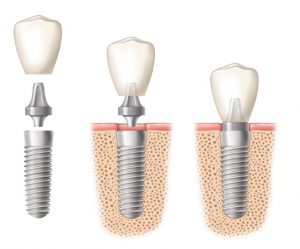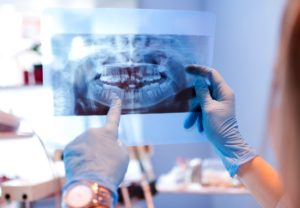Header logo
header top contact widget
Insurance Coverage & Payment Plans
Understanding Dental Implants & Their Benefits
Posted on Nov 03, 2020 by William J. Claiborne, DDS MS
When you lose a natural tooth, even one that isn’t visible when you smile, its absence causes a reaction that takes place below the gum line. Many people are unaware of what occurs – at first. When it becomes obvious, it leads to problems that are not only bothersome, they are detrimental to your overall health.
The absence of a tooth root in the upper or lower jaw bone is a loss of stimulation the bone mass where it was once positioned. These roots provide stimulation and nourishment that enables the bone to maintain a healthy mass. Without the presence of tooth roots, the bone begins to “melt away.” The term for this process is known as resorption.
Resorption begins shortly after the tooth root is removed. Once it begins, it continues at an ever-increasing pace. For example, the first year after a tooth root is missing, the loss of bone may be minimal. With each passing year, the rate of loss accelerates.
As the bone shrinks in height, the natural tooth roots adjacent to the area of missing teeth are vulnerable to movement and root damage. On average, the teeth most likely to be lost are the ones next to areas of tooth loss.
For the support of remaining natural teeth, it’s important to replace missing teeth as soon as possible so adjacent teeth can retain their proper positions. It is even more important to replace missing teeth before bone loss begins. And, it’s HOW you replace them that’s most important.
Because dental implants replace the tooth above the gum line AND the root portion below it, the bone is able to retain its mass. Dental implants are designed to restore the look, feel and chewing stability like that of natural teeth.
As the advantages of dental implants become more familiar for natural tooth replacement, there are still some misconceptions among the general population. The following will hopefully clear up some of the confusion.
First, Dental Implants are a term that describes 3 components. The “implanted” portion is placed in your jaw bone where a tooth root was once held. The “implant” is not what holds the tooth. It serves to anchor an attached tooth (or bridge of two or more teeth).
Made from titanium, this metal bonds to living bone successfully. As a matter of fact, dental implants have one of the highest success rates of any implant-in-bone procedures.
The implanted portion becomes anchored in the jaw bone through a process known as ‘osseo-integration.’ Once the implant has been secured by the bone, a post is inserted into the center of the implant. This post is known as an abutment.
The replacement tooth (or teeth) is usually made of porcelain. This is the portion that you see and looks just like a natural tooth. This is known as a restoration or crown. It is attached securely to this post.
 Porcelain is commonly used to create the restorations because they provide the most durable material possible and have the look and feel of a natural tooth. Porcelain has a luminosity of natural teeth and even reflects light as a natural tooth would. Porcelain is also very resistant to staining.
Porcelain is commonly used to create the restorations because they provide the most durable material possible and have the look and feel of a natural tooth. Porcelain has a luminosity of natural teeth and even reflects light as a natural tooth would. Porcelain is also very resistant to staining.
When missing more than one tooth in one area, an implant is not always necessary to replace each one. As mentioned prior, one implant can often hold two or a bridge of teeth. Several strategically-placed implants may also be used support a full arch of teeth.
When people can chew properly and eat a healthy diet, their overall health is better. And, without the fear of embarrassing slips or clicks (often associated with denture wear), being socially active can continue to be a positive part of a happy life.
Dental implants restore the ability to eat with stability, chew comfortably, laugh and speak with confidence. Dental implants do not decay and will never need root canals. And, with proper care, they’ll last your lifetime.
There are many types of implants, each designed to accommodate specific needs. Many dental implants are chosen and placed by a Periodontist. This is a dental specialist who has extensive and specialized training in the diagnosis and placement of all types of dental implants. He or she can select the one that will work best for you.
Proper placement and support in caring for implants is an important part of a successful outcome. Dental Implants CAN fail. This is why a periodontal specialist can be an asset to your investment.
If infection sets in and reaches the implanted portion, the implant may need to be removed so treatment can resolve the problem. Your periodontist can assess gum health prior to placement and monitor your healing process to help minimize this risk.
There are other threats to dental implant success. Clenching or grinding teeth can also contribute to implant failure. Smoking complicates and delays the healing process and is also a known contributor to implant failure. Again, a periodontist can oversee your care to optimize your ability to enjoy a lifetime of confident smiles.
Call 828-274-9440 to arrange a consultation. During this time, we can discuss treatment that can achieve your needs and goals as well as the process and anticipated costs. If dental fear is a concern, I’ll also explain sedation options. We offer both oral sedation and IV sedation, if a “twilight sleep” state is preferred. Here, you’ll find your comfort is always a priority.
Is Your Insurance Ruining Your Oral Health?
Posted on Nov 26, 2019 by William J. Claiborne, DDS MS
A necessary ‘evil.’
These days, insurance coverage seems to be an ever-expanding chunk out of paychecks. Even so, coverages seem to be getting more and more limited.
Yet, health insurance is an investment that provides peace of mind and reminds us that we need to do all we can to stay healthy – and NOT need it! Deductibles, uncovered items, and prescriptions can drain the wallet in spite of what is shelled out for monthly premiums.
Regardless of the insurance coverage you have, taking full advantage of its benefits is an annual goal. Some people have Health Savings Accounts (HSA) to give some padding for certain expenses not covered by insurances.
Because of out-of-pocket expenses, dental patients sometimes make decisions on accepting treatment based on what their insurance covers. This can be detrimental to the patient.
Dental insurance was developed to give people some help for basic annual expenses. For many, this includes twice-a-year dental exams and cleanings. Some policies include assistance for an annual crown or filling, and some coverage for periodontal (gum) therapy to treat gum disease.
Although adults may see these coverages as ample, they can be far from sufficient some years. For aging adults or people who have conditions such as diabetes or take medications that have an oral dryness side effect, basic insurance coverage can be far from what is in your best interest.
Keep in mind that insurance companies are for-profit businesses. What these companies deem coverage-worthy may be far from what is best for a patient’s long term oral health.
Think about this … As of Aug. 2, 2018, publicly traded health care companies amassed $47 billion in profit. (https://www.axios.com/health-care-industry-on-track-massive-q2-profits-1533226387-dacec8f8-c9f5-406c-a49e-1103e3316c64.html) That’s BILLION.
Sadly, insurance companies tend to serve as judge and jury for some people when it comes to treatment decisions. If an insurance company overrules what a dentist or dental specialist advises, it can leave the patient with an even more-complex situation.
They also use additional limiting terms such as “usual and customary.” This means that it is the insurance company that determines what is reimbursed for the treatment rather than the skill level and reputation of the provider.
Another dilemma for today’s insured patient has to do with the treatment recommended. For instance, when I consult with a patient who is missing teeth, I typically advise dental implants. My recommendation is based upon what will provide the patient with a lifelong solution for missing teeth as well as other benefits.
I look at a dental implant as the ideal in tooth replacement, since it is held in the jaw bone just as natural tooth roots. An implant restores the dependable foundation necessary for biting and chewing, enabling the patient to eat a healthy diet and chew foods comfortably, which supports the digestive system and overall health.
Dental implants are a more expensive option (initially) than crown-&-bridge combinations, dentures, or partials. They are designed to last a lifetime; often far beyond the span of time an average policy holder would stick with the insuring company.
As beneficial as they are to your overall health, dental implants are often deemed as ‘elective’ by insurance companies. This is where the patient must decide: “Is protecting my overall health and smiling confidence a priority to me or should I go with what my insurance coverage allows?”
What it comes down to is, essentially, how we perceive insurance coverage. While major medical insurance gives us peace of mind should we experience a health challenge that would otherwise drain us financially, dental insurance coverages are different.
Dental insurance, for the most part with most policies, is structured as a ‘support’ for helping those covered to maintain a healthy mouth. For people who already have good oral health and are able to tend to it sufficiently between checkups, this is fine. However, for most American adults, tooth repair, tooth loss and gum problems are a fact of life, particularly as we age.
For most of us, the decisions we make today will affect us in the years to come. When it comes to your oral health, don’t let your long-term oral wellness, the longevity of your teeth, the comfort of healthy eating, or the confidence of smiling and laughter be dictated by what insurance coverage allows.
When it comes to your smile, put your needs first.
If you trust your dentist and others involved to guide you towards good oral health and maintaining your smile, consider their recommendations and ask questions. Be an informed consumer. But, most importantly, make decisions that are in your best interest rather than that a for-profit insurance company deems is worthy for your smile.
If you don’t have regular dental care and would like recommendations, feel free to contact us at 828-274-9440. We work with exceptional general dentists in Western North Carolina and will be proud to connect you. Or, feel free to begin with a thorough periodontal exam here. We will make recommendations based upon your unique needs and goals.
Know The Unseen Risks Of Wearing Dentures
Posted on Sep 19, 2019 by William J. Claiborne, DDS MS
As an Asheville periodontist, my goal is to provide each patient with the very best so they can enjoy a healthy, confident smile. For patients who have lost one or more natural teeth, some come to me because they want to avoid ending up having to wear a full or part ial denture. For those who wear one and are unhappy with the feel and function, we are sought out as specialists in the diagnosis and placement of dental implants.
ial denture. For those who wear one and are unhappy with the feel and function, we are sought out as specialists in the diagnosis and placement of dental implants.
Denture wearers, especially those who have worn dentures for many years, can quickly become dissatisfied with the uncomfortable rubbing and difficulty eating foods they once enjoyed. Although their ‘appliance’ may have fit well when first made, changes in the fit, over time, are due to what is taking place below the gum tissues. These changes aren’t obvious, at first.
When first made, a denture is custom-designed to fit snugly to the unique contours of the gum ridge. This ‘ridge’ is the raised arch where natural teeth were once held. Over time, denture wearers begin to notice that the denture moves while chewing certain foods. This can rub sore spots on gums. As the denture loosens more, even using denture adhesives or pastes don’t help much.
Denture patients also learn that it can be painful for something as small as a sesame seed to become trapped between their denture and gums, piercing into tender gum tissues. Some people eventually switch to a diet of soft foods that dissolve easily to avoid rigorous chewing. Because of fear of embarrassing slips, others begin to decline social invitations when they are centered around food.
The problem for a denture wearer is what is happening underneath the gums. The looser fit is not because the denture has expanded – it’s the decline of the jaw bone. This occurs with the absence of tooth roots, which once provided nourishment and stimulation to the bone that supported them.
When natural tooth roots are removed, the jaw bone begins to shrink. This decline in bone mass also contributes to changes in facial appearance, such as deep wrinkling around the mouth and the formation of jowls.
The process of bone loss continues as the gum ridge your denture was contoured to flattens. Relines may temporarily adjust the denture to accommodate some of the change. However, as the jaw bone continues to decline, the denture continues to be difficult to keep in place.
The denture itself merely adds to the problem of bone loss. The pressure of wearing a denture actually accelerates the rate of bone loss. Since a number of denture wearers also sleep in their dentures, the 24/7 pressure speeds this rate even more.
Long-time denture wearers often complain that they are not able to chew, with some admitting they have to even remove their denture to eat. Fear of embarrassment is another common complaint. Speaking, laughing and even sneezing in the presence of others can create embarrassing moments that leave lasting impressions.
The solution to these problems – dental implants. Not only do implants restore the ability to bite and chew comfortably, they halt bone loss that is associated with dentures. Because they are held by the jaw bone, just as natural tooth roots once were, implants recreate the stimulation needed by the jaw bone to maintain its mass.
Does your denture bring to mind words like rocky, wobbly and slippery? If so, the problem will only worsen over time. When people choose dental implants to replace an ill-fitting denture, they can smile, laugh and chew with confidence.
Eating a healthy diet, socializing with friends and family, and feeling confident are essential to a healthy, happy life. Call our friendly Asheville periodontal dental office: 828-254-9440 to schedule an initial appointment. (A referral is not required). During this time, I’ll explain the type of implants that may be best for your needs as well as comfort options, including oral and IV sedation (“twilight sleep”). We are also happy to discuss estimated costs and payment options.
Get The Most For Your Investment When Replacing Teeth.
Posted on Jun 12, 2019 by William J. Claiborne, DDS MS
Losing a natural tooth is a big deal. Its loss not only leaves a gap in the appearance of a smile, its absence can lead to movement of surrounding teeth. 
Without all teeth in their proper positions, an open area can cause others to tilt and turn. Additionally, the one above or below will grow longer without having its ‘roommate.’ These issues can lead to broken, fractured, or chipped teeth.
Replacing a tooth involves decisions, and costs. While there are ‘cheap’ ways to replace a tooth, the ideal method – a dental implant – offers lifetime replacement that actually enhances the well-being and lifespan of surrounding teeth.
In dental implant treatment, the ‘implanted’ portion is positioned into the jaw bone as a tooth root replacement. This provides the teeth attached the same foundation as natural tooth roots have. A partial or bridge simply sits on top of gum tissues and relies on adjacent teeth for support.
When a tooth must serve as a support for ‘prosthetic’ teeth, its key role becomes greater. With the added pressure and stress to the natural tooth, there are also more risks to its structure on its own.
Because of the ability to restore the presence of natural teeth to such a great extent, dental implants are the preferred choice for replacement. Although the costs seem greater, over time, the benefits far outweigh the expense. This is why more and more adults are choosing implants to replace one, several, or all missing teeth.
However, there are many factors that can come into play when going forward with a dental implant. Your choice of doctor to place the implanted portion can greatly increase your potential to enjoy your dental implant for a lifetime.
As a Periodontist, my specialty encompasses treatment of all levels of gum disease, the re-contouring of gum tissues, and advanced training in the diagnosis and placement of dental implants. This includes the proper selection of the implant type best for each patient’s needs as well as placement at correct depths and angles.
The most troubling thing I see in implant dentistry is when a patient opted for a “good deal” with a less-experienced doctor, and having to remove a ‘failed’ implant.
Along with an intricate knowledge of the specific type of implant needed, proper placement angles and depth have much to do with the overall success of the implant. For optimal results, the doctor placing the implant should be skilled in the selection of the implant angles and positioning depths.
For example, an implant placed in the upper jaw in too-shallow bone can work its way into the sinus cavity. A lower implant in insufficient bone depth can reach a nerve that runs horizontally through the lower jaw (the mandible).
Additionally, the shape, size and the number of teeth to be attached to an implant have much to do with the type of implant system selected. When the placement doctor is only familiar with one or two types, disasters can occur.
In our Asheville periodontal office, we enjoy restoring the health and appearance of smiles. We also help patients who once struggled with dentures or partials to resume eating the foods they love again and laugh confidently in social gatherings.
The doctor is not the sole factor in success, however, Along with proper selection and placement, a patient must take measures to ensure proper oral hygiene at home. Oral bacteria can contribute to an infection that works its way into the bone surrounding the implant. In some cases, the only way to resolve the infection is to remove the implant.
When a patient entrusts their implant treatment to a skilled doctor and adheres to hygiene and healing guidelines, having an implant fail is very unlikely. The success rate of today’s implant dentistry is excellent – over 97 percent.
If you are considering dental implants, increase your potential for a successful outcome by asking a Periodontist to join your dentist in team treatment. Most general dentists have close relationships with periodontal specialists for implant placement and in treating gum disease.
Feel free to discuss your specific needs and desires before you make your decision. Call (828) 274-9440 to schedule a consultation.
Recent Posts
Categories
Archives
- September 2024
- August 2024
- July 2024
- June 2024
- May 2024
- April 2024
- March 2024
- February 2024
- January 2024
- December 2023
- November 2023
- October 2023
- September 2023
- August 2023
- July 2023
- June 2023
- May 2023
- April 2023
- March 2023
- February 2023
- January 2023
- December 2022
- November 2022
- October 2022
- September 2022
- August 2022
- July 2022
- June 2022
- May 2022
- April 2022
- March 2022
- February 2022
- January 2022
- December 2021
- November 2021
- October 2021
- September 2021
- August 2021
- July 2021
- June 2021
- May 2021
- April 2021
- March 2021
- February 2021
- January 2021
- December 2020
- November 2020
- October 2020
- September 2020
- August 2020
- July 2020
- June 2020
- May 2020
- April 2020
- March 2020
- February 2020
- January 2020
- December 2019
- November 2019
- October 2019
- September 2019
- August 2019
- July 2019
- June 2019
- May 2019
- April 2019
- March 2019
- February 2019
- January 2019
- December 2018
- November 2018
- October 2018
- September 2018
- August 2018
- July 2018
- June 2018
- May 2018
- April 2018
- March 2018
- February 2018
- January 2018
- December 2017
- November 2017
- October 2017
- September 2017
- August 2017
- July 2017
- June 2017
- May 2017
- April 2017
- March 2017
- February 2017
- January 2017
- December 2016
- November 2016
- October 2016
- September 2016
- August 2016
- July 2016
- June 2016
- May 2016
- April 2016
- March 2016
- February 2016
- January 2016
- December 2015
- November 2015
- October 2015
- September 2015
- August 2015
- July 2015
- June 2015
- May 2015
- April 2015
- March 2015
- February 2015
- January 2015
- December 2014
- November 2014
- October 2014
- September 2014
- August 2014
- July 2014
- June 2014
- May 2014
- April 2014
- March 2014
- February 2014
- January 2014
- December 2013
- November 2013
- October 2013
- September 2013
- August 2013
- July 2013
- June 2013
- May 2013
- April 2013
- March 2013
- February 2013
- January 2013
- December 2012
- November 2012
- October 2012
- September 2012
- August 2012
- July 2012
- June 2012


